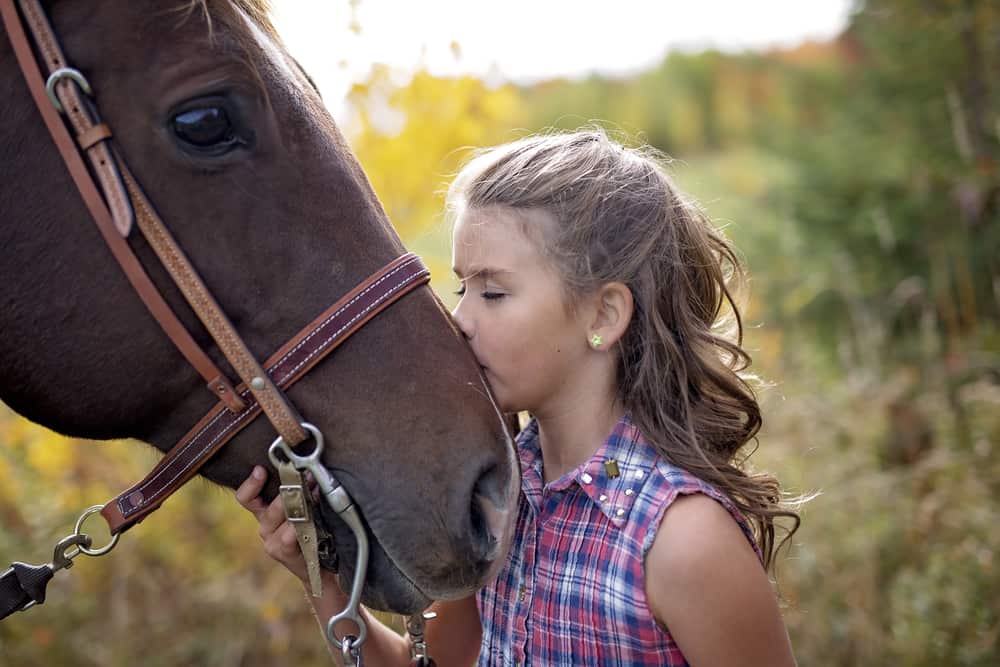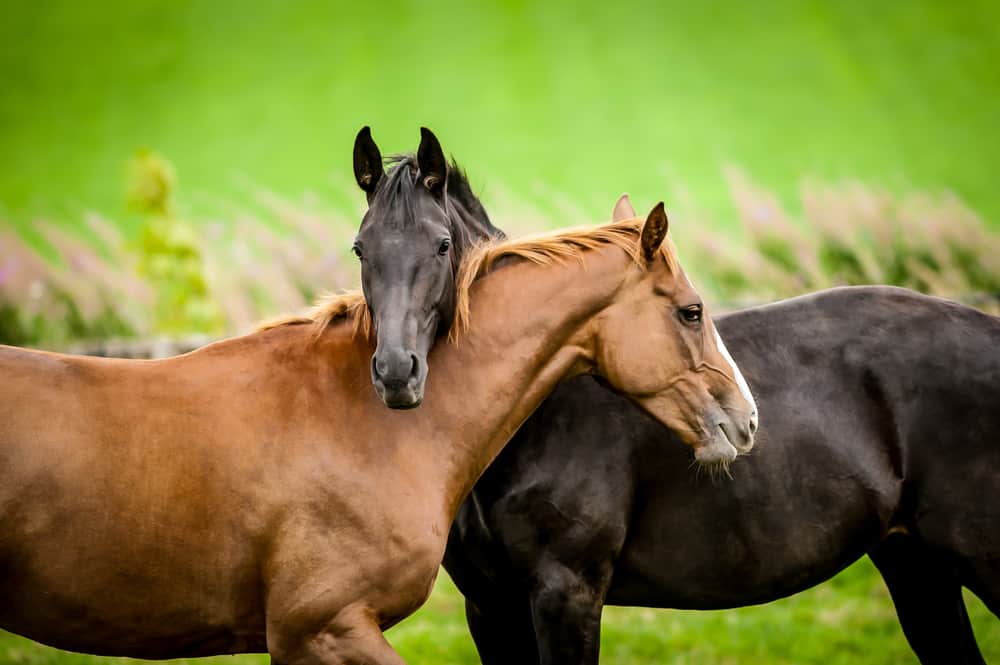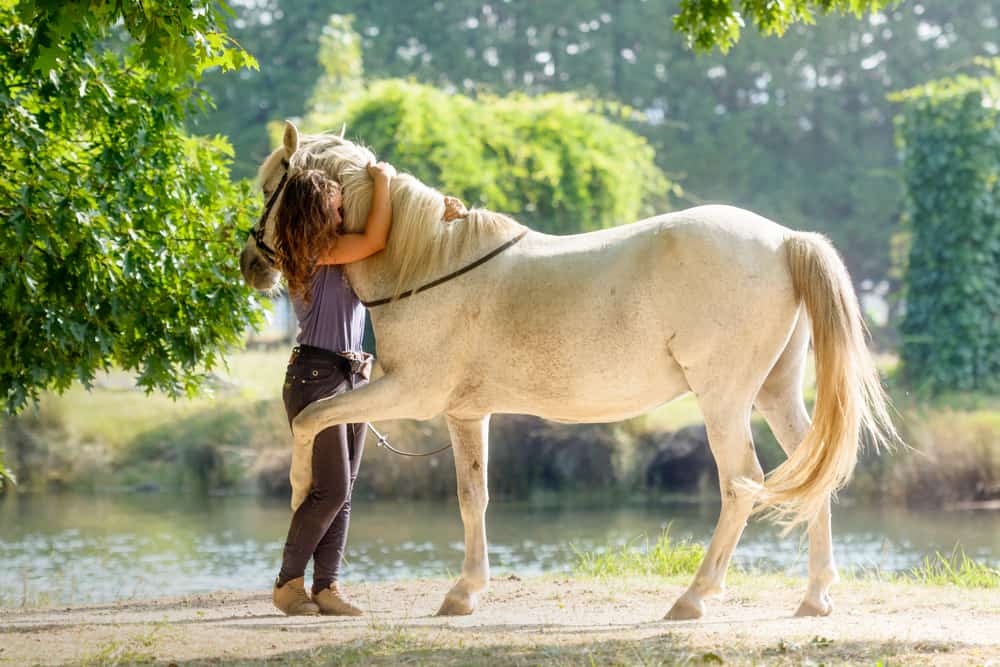
You may be wondering how to tell if your horse loves you or his paddock-mates. And if they do, how would they show it? When resting their head on your shoulder, is this a display of affection, or are you simply a convenient headrest? Horses are social beings; they enjoy being in the company of others. They form strong bonds with each other and also with their humans.
Horses, much like people, show affection in different ways. Some are super cuddly and want to be in your space all the time, while others might prefer a quick pat and then be left alone with their grass. As you spend time with and get to know a particular horse, you will learn their ways, their quirks and how they, as an individual, show affection.
Let’s look at how horses show affection towards each other, towards humans, and the psychology behind affectionate horse behavior.
A little on psychology and how it affects the way horses show affection
When thinking about the different ways in which horses show affection, you first need to understand a bit about their psychology, their natural behaviors and how they interact with each other to give you a better understanding of how they might try to interact with people.
Domesticated horses have had to adapt their natural behavior to better fit within the human realm. These horses need to find acceptable ways in which to communicate with their people. These behaviors differ significantly from the instinctive behaviors of their wild ancestors.
How do wild horses show affection?
Horses are naturally social beings. In the wild, they live together in groups called herds, typically made up of between three and twenty horses. Some herds can even be significantly larger. The herd members follow a strict hierarchy or pecking-order, which involves a series of complex herd dynamics. They communicate with each other through touch, body language and vocalization.
As social animals, strong bonds develop between the members of the herd. Different relationships formed within the group will assist in maintaining balance and also social standing. Displays of affection between the members are essential and help build and strengthen their relationships.
Does gender affect how horses show affection?
Leading a herd in the wild is the matriarch or alpha female. She is usually an older mare, with the experience and wisdom required to make crucial decisions for the herd. She is also the and disciplinarian and the herd’s peacemaker, ensuring the members are kept in line and behave accordingly.
While the alpha female is in charge of the herd, their movements, behavior, and dynamics, the alpha male (the stallion) will serve to protect the herd and perform his duties by breeding with the mares within the group. While on the move, the matriarch will take up the lead, guiding the horses to food and water while the stallion follows at the back, guarding his herd against other stallions.
So, mares are natural leaders. They are strong, assertive, and dominant. This goes a long way in explaining why mares have earned themselves a reputation for being difficult and stubborn. Stallions have an instinctive urge to breed and fight off any competition.
But what about geldings? A gelding is a castrated (gelded) male horse, essentially removing the need to breed and fight and, therefore, any physiological reason to show aggressive or dominant behavior. They tend to be more relaxed and easy-going than mares and stallions, and for this reason, many people prefer working with geldings over stallions or mares.
Do different breeds of horses behave in different ways?
Domesticated breeds of horses were developed over generations to possess specific characteristics, both physically and also temperamentally. For example, if you observe an Arabian, they are hot blooded, incredibly smart and sharp-minded. A Thoroughbred has an inherent flight instinct as they have been bred to gallop in races, and a cold-blooded Shire horse is more relaxed, patient and docile, bred to perform slow, heavy farm work in close quarters with their masters.
Nature versus nurture
We have looked at horses’ natural behavior in the wild, horses of different breeds, and gender. All of the above will affect how your horse may show affection. But what about their upbringing?
Some horses prefer the company of horses over people, while others adore time spent with their humans. Hand-reared horses and those brought up in close contact with people who showered them with love tend to be far more affectionate toward humans than horses brought up with less human connection or a less loving hand.

Different ways that horses show affection
Horses are capable of so much love, and there are so many ways in which they might show their affection. This applies to how they interact both with people and other horses. Vocal greetings, nuzzling, mutual grooming, and playing are ways in which a horse might show affection toward the members of their social group, in other words, toward both horses and people.
How do horses show affection to other horses?
It is common to see horses excitedly greeting one another. For example, when one horse is out in the paddock, and their buddy is on the way, they might vocalize their joy at seeing their friend by neighing loudly or nickering softly. As their friend arrives and is released into the paddock, they will touch noses or muzzle each other in recognition. They will take time to greet one another before heading out into the pasture or field together to get started with their daily routine.
It’s a common sight to see two horses standing against each other, facing in opposite directions and biting or scratching each other’s backs and withers. This act is called mutual grooming. By performing this act, they help each other by relieving an itch in an otherwise impossible to reach spot, by ridding each other of parasites or simply bonding. You will also find these horses taking a quiet nap together, standing head to tail and swatting the flies from each other’s faces.
Displays of affection between individual horses will be dependent on the dynamics between the members of the herd and the pecking order. Horses tend to be very clear about who their friends are, which horses they are simply tolerating and which ones they prefer to avoid altogether. They will have the same sentiments toward certain people.
How do horses show affection to people?
Horses can show affection to people, especially those with whom they have formed a strong bond. As horses grow and learn, they realize that humans aren’t appreciative of some types of affection as other horses are, such as mutual grooming. While this is a loving gesture between horses, it hurts and will undoubtedly land up with a sharp reprimand when performed on a person.
6 ways horses show affection to people
There are so many ways that a horse might try to show you affection. Below are a few of the most common ways that a horse will show affection to its people. Not all horses will use the same methods of showing affection. You need to be open to allowing them the freedom of expression and try not to discourage their efforts to communicate, or they will eventually stop trying.
1. Calling out to you
When a horse calls out to you as they see you approaching by neighing or nickering, they express that they are happy and excited to see you and that they have missed you while you have been away. This horse might see you as a friend, and they want to be close to you.
2. Coming over to greet you
If a horse is happy to see you, they will come over excitedly to greet you on your arrival, whether at the stable door or the paddock fence, displaying that they enjoy your company and want to spend time in your presence. Horses don’t generally spend their time doing anything that doesn’t interest them, so you should be pleased when they show such an interest in you.
3. Nudging and nibbling
By nudging and nibbling gently at you, your horse tells you that they are craving physical affection and connection with you. Nudging is a way of getting your attention or interacting with you, showing curiosity in something you’re holding and displaying a general desire to be involved in whatever it is that you might be doing.
Mutual grooming is performed between horses to show affection and strengthen or maintain the bonds within the herd. If they nibble and nuzzle at you gently (which might most commonly occur during a grooming session), this is a way of showing you that they care about you. They value your relationship. They appreciate your efforts, and they are doing their part to maintain or strengthen the bond between you. Some horses will attempt to nuzzle into your neck and face, and while the idea of this is so sweet, be aware of the nip that may follow.
4. Pressing or resting their head against you
When a horse quietly presses their forehead against your chest or rests their head over your shoulder and relaxes in this position, sometimes even closing their eyes, this is a huge sign of trust and affection. You can imagine this as a sort of horse-hug. This behavior is typical among wild and domesticated horses alike.
While it is charming and loving, just like mutual grooming, be careful of the potential dangers it poses to the person. A horse’s head is big and solid. Always take care when working with these large animals. I have seen more than one person with a bruised face from just this action. All you need is a pesky fly to land on the horse’s face, and he will react with a sharp jerk.
5. Displays of trust and respect
When a horse trusts you and respects you as part of their herd, that’s a lovely gesture. Some horses follow their people around, which is a sign they view you as a leader, and they trust that you will take care of them. These horses are generally more obedient and take so much pleasure in pleasing you and will make every effort to do so.
When a horse relaxes in your presence, for example, by resting a hind-leg, lowering their head and taking a nap, they are telling you they feel completely safe with you. Horses are very vulnerable when they are lying down, and doing this in your presence is quite an honor, especially if they allow you to approach and even sit with them in this position. Even though these may not be physical gestures, they are still acts of affection.
6. Sharing breath
When a horse lifts his head and blows gently through his nostrils into your face, this is a huge sign of love, trust and affection. Horses will do this with other horses they regard as a great and trusted friend or family.

How to encourage a horse to be more affectionate towards you
I recently worked with a horse who did not have the most loving early life. Initially, he was suspicious of people and always a little jumpy if I moved too fast or reached a hand toward him. I didn’t let these behaviors deter me and continued working quietly with him as I would with any horse. He eventually started to relax in my presence, reaching a point where he seemed to ignore me completely.
After a few weeks of persistence, and entirely out of nowhere, he approached me. He stuck his nose right into my face, breathed all over me, and then proceeded to press his chin onto the area between my shoulder and neck. It didn’t take him more than a few seconds to relax in this position and allow me to carry some of his weight. We stood like this for perhaps a minute, and then I gently stroked his nose and asked him to lift his head from my shoulder. He did so and instead pressed it against my chest for a few minutes.
This display was his way of showing me that he trusted and respected me. During the days that followed, his displays of affection ranged from enormous acts of love to absolutely none at all. As much as we desire this kind of affection from all the horses we work with, we need to be respectful of their own desires and moods.
Patience and understanding
You cannot force a horse to be affectionate with you. If you keep pushing the issue, you will only succeed in irritating the horse and land up with the opposite result to what you were hoping for. Showing understanding and allowing the horse to come to you in its own time is the best thing you can do. Make yourself available, be kind and patient.
There is also a fine line between kindness and allowing the horse to push you around and walk all over you, which will not do any good in developing respect within the relationship. Gaining the horse’s respect is the first step toward also earning its trust and love.
Don’t be too pushy. Allow the horse to give you affection. Make yourself available and when the horse is showing you any physical love, be still and accept it. If you constantly stroke and try to reciprocate the affection every time the horse approaches you, you block his ability to give you love. It is like a game of giving and taking.
Conclusion
Horses are capable of so much love, and they form deep bonds with their families, friends, and people. Not all horses will show affection in the same way, and it is your job to practice interactional awareness to understand each horse as an individual. Just because a horse doesn’t nuzzle you while you are grooming them or neigh out to you every time they see you, it does not mean that they don’t love you. They simply have their unique way of showing their affection.
